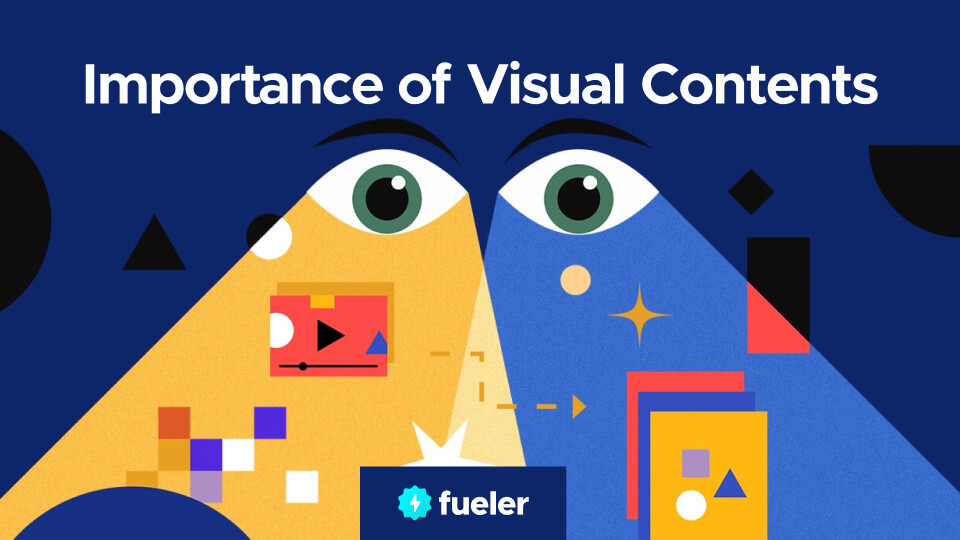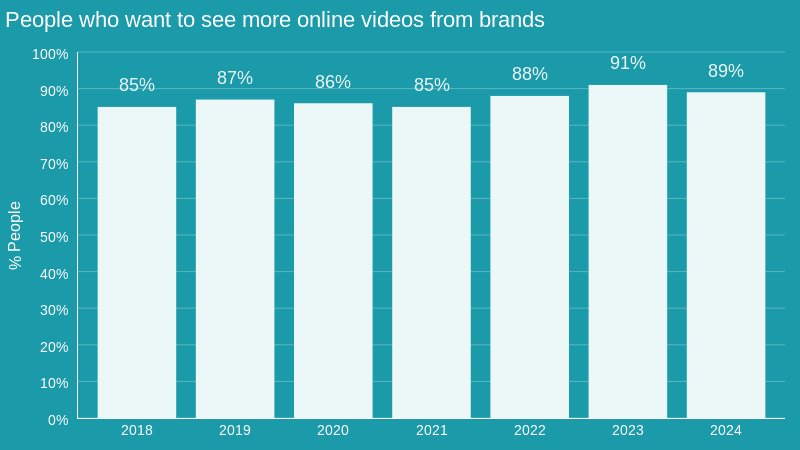Increasing Engagement with Visual Content: Best Practices for Creatives

Team Fueler
23 Oct, 2024

From social media stories to cloud digital signage, visual content dominates today's digital landscape. Hence, incorporating effective visual elements into a content strategy has never been more crucial for creatives.
Whether you're a designer, marketer, or content creator, enhancing engagement through visuals can amplify your message and create a lasting impact on your audience.
Let's explore practical strategies and best practices for using visual content to drive engagement.
The Power of Visual Content
Visual content connects people more quickly than text alone due to our neurological wiring. Researchers from the University of Rochester noted that nearly 50% of the human brain's resources are dedicated to visual processing.
Engaging visual content can also improve brand recall, build emotional connections, and enhance user experience. That’s why visual elements such as images, videos, infographics, and even cloud digital signage have become essential tools for driving engagement online. Android digital signage helps creatives share and manage visual content seamlessly across multiple displays, making it easier to maintain audience engagement.
Best Practices for Effective Visual Content
Given the advantages of visuals, it's clear they should be integral to your content strategy. Here are some best practices to ensure their effective use.
1. Understand Your Audience
One of the most critical aspects of creating engaging visual content is understanding your audience. Knowing their preferences, interests, and behaviors can help you tailor your visuals to resonate with them.
Start by conducting audience research to gather insights into what types of content they engage with the most.
Consider factors such as demographics, psychographics, and cultural influences. For example, younger audiences may prefer dynamic and interactive content, while older audiences might appreciate more traditional and informative visuals.
Aligning your visuals with your audience's preferences can help you create more meaningful and impactful content.
2. Focus on High-Quality, Relevant Visuals
High-quality visuals that align with your written content are another critical factor in improving engagement. Poorly designed or irrelevant visuals can confuse or alienate your audience. Instead, invest in clear, professional imagery that complements your message. Offering users the ability to expand images tailored to your brand can make your visuals more engaging and impactful than standard stock photos.
Custom visuals, such as unique graphics or images tailored to your brand, perform better than stock photos. These reflect your authenticity, helping to build trust with your audience.
Key Tip: Stay consistent with your brand’s visual identity. From colors to fonts, ensure your visuals reflect your brand’s voice and style.
3. Create a Visual Hierarchy
Visual hierarchy is essential for guiding your audience’s attention to the most important elements of your content. Structuring your visuals to lead viewers through a logical progression ensures that key messages are not overlooked.
People typically scan content in an F-pattern, focusing first on the page's top-left corner. This area is prime real estate for placing critical information, as it’s where viewers’ eyes naturally gravitate.
To effectively establish a visual hierarchy, use size, color, contrast, and placement to differentiate between various design elements. Larger, bolder, or more vibrant components will naturally draw attention first. Additionally, consistent alignment and spacing can help create a clean and organized look, making it easier for viewers to navigate through your content.
4. Leverage Video Content
Video content has seen explosive growth in recent years, and it’s not slowing down. A study by Wyzowl found that 89% of consumers want to see more online video content from brands. Video engages senses—sight and sound—making it highly effective at quickly holding attention and conveying messages.
Video content doesn’t need to be elaborate or expensive. Short, snappy clips that are informative or entertaining can boost audience engagement. Consider using videos for product demonstrations, tutorials, or behind-the-scenes content to humanize your brand.
5. Do Storytelling Through Visuals
Telling a story through visuals is an art form. Compelling visual narratives evoke emotions and create deeper connections with your audience. By carefully curating a series of images, videos, or animations, you can guide viewers through an emotional journey that keeps them engaged until the very end.
One effective way to weave storytelling into visual content is by showcasing user-generated content or testimonials through imagery. Featuring real people or their experiences can add a personal touch that resonates with potential customers, increasing trust and engagement.
6. Enhance Accessibility in Visual Content
In the quest for engagement, it’s essential not to overlook accessibility. Making visual content accessible to everyone, including people with disabilities, can expand your reach and foster inclusivity. To enhance accessibility:
- Use descriptive alt text for images so that screen readers can convey information to visually impaired users.
- Ensure sufficient contrast between text and background in your visuals.
- Add captions and transcripts to videos for those who are hearing impaired.
Visual Content Formats That Drive Engagement
Aside from videos, which were mentioned earlier, other visual content formats effectively convey complex information and stir emotions, leading to better engagement.
Infographics
Infographics are a great way to present complex information in a visually appealing and easy-to-digest format. These visuals combine data and design to tell a story, making them an effective way to convey statistics, processes, or comparisons.
When designing infographics, ensure that information is clear and relevant. Also, keep the design simple and focus on highlighting key points with a cohesive visual flow.
Interactive Content
Interactive visuals, such as polls, quizzes, or clickable infographics, increase engagement by allowing the audience to participate actively. These types of content not only entertain users but also encourage more extended interactions, leading to better engagement metrics.
For instance, interactive infographics that change dynamically as the user engages with them can offer a more immersive experience, leading to increased sharing and return visits.
Optimizing Visual Content for Different Platforms
Content specifically optimized for individual platforms garners more engagement than generic visual content. Therefore, it's essential to tailor your visuals to fit the nuances of each platform for maximum impact.
Social Media
Social media platforms are powerful channels for distributing visual content and driving engagement. As each platform has its own unique features and audience, it’s a must to customize your visuals accordingly.
- Instagram and Pinterest: These visually oriented platforms are ideal for sharing high-quality images and videos. Use eye-catching visuals, relevant hashtags, and engaging captions to attract followers and drive interaction.
- Facebook and Twitter: These platforms support a mix of media formats, including images, videos, and GIFs. Use visuals to complement your text-based posts and enhance the overall impact of your content.
- LinkedIn: For professional and B2B audiences, LinkedIn is the go-to platform. Use visuals to showcase your expertise, share industry insights, and promote your brand.
- YouTube and TikTok: Both platforms thrive on video content. YouTube is perfect for long-form content, tutorials, and in-depth discussions, while TikTok excels with short, engaging clips and trending challenges. Tailor your video strategy to match each platform's unique style and audience preferences.
Websites and Blogs
Visuals on websites and blogs should enhance readability and support your written content. Including images, videos, or infographics between text blocks breaks up long paragraphs, making it easier for readers to digest information.
Remember to compress image sizes to prevent slowing down page load times, which can negatively affect engagement.
Measuring Success
To ensure your visual content is effective, track and analyze its performance. Use analytics tools to measure key metrics such as views, likes, shares, and comments. Understanding which visuals resonate the most with your audience can help refine your content strategy and achieve better results.
Additionally, A/B testing should be considered to compare different visuals and identify what drives the most engagement. This data-driven approach lets you make informed decisions and continuously improve visual content.
Conclusion
Compelling visual content has the power to transform the way you engage with your audience. Using high-quality, relevant visuals, leveraging the growing popularity of video, and optimizing content for various platforms can aid you in significantly enhancing people's engagement with your brand.
Additionally, storytelling, interactivity, and accessibility are key elements that should be considered to create a more inclusive and captivating visual strategy.
As the digital landscape evolves, staying adaptable and creative with your visual content approach will be essential to stand out from the competition.
Frequently Asked Questions
1. What are some emerging trends in visual content?
Emerging trends in visual content include augmented reality (AR) experiences, 360-degree videos, and personalized visuals. These innovations offer new ways to engage audiences and create immersive experiences.
2. What tools can help me create high-quality visuals?
Numerous tools are available for creating high-quality visuals, including Adobe Creative Suite (Photoshop, Illustrator, Premiere Pro), Canva, and Figma. These tools offer a range of features for designing and editing images, videos, and other visual content.
3. How can small businesses create professional-looking visual content on a budget?
Several cost-effective solutions exist, including template-based design tools, stock photo subscriptions, and automated video creation platforms. Many offer free tiers or affordable monthly plans suitable for small businesses.
4. What role does AI play in visual content creation?
AI tools are increasingly used for image enhancement, automated video creation, and personalized visual content generation. However, human oversight remains crucial for maintaining brand voice and ensuring content relevance.
About Fueler:
Fueler is a career portfolio platform that helps companies find the best talents for their organization based on their proof of work.
You can create your portfolio on Fueler, thousands of freelancers around the use Fueler to create their professional-looking portfolios and become financially independent. Discover inspiration for your portfolio
Sign up for free on Fueler or get in touch to learn more.



